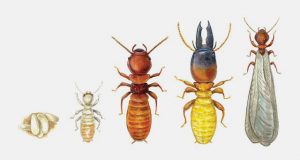
One of the biggest pest nightmares at homes and offices are the Termites. They date back more than 120 million years, thus proving their might when it comes to survival. The reason they are so dreadful is because they are not specific to any season, they may attack your property at any time of the year, with theirinnate ability to thrive while getting undetected. Once a property is infested by termites, just by silently eating into the structural components, namely wooden furniture, ceilings, floors, walls and attics, etc., they can make the property turn into unliveable space. Every year damages caused by this single type of pest alone have proved to cost billions of rupees. They secretly form colonies with as many as two million members, thus making them on the top of most notorious of all pests.
So how do you find out if your home is infested with these ‘Silent Destroyers’?
- Sagging floors and ceilings,
- Traces of dust similar to dust,
- Piles of wings that resemble scales,
- Solid wood sounding hollow when you hit it,
- Mud trails on exterior walls,
- Dry bubbled paint on your furniture.
Contrary to a popular belief, termites are not partial to aging wooden structures; infact they are equally inclined to infest new buildings and constructions as well as any new piece of furniture. The hard, saw-toothed jaws of termites work like shears and are able to bite off extremely small fragments of wood, one piece at a time, thus over time, they can collapse a building entirely.
However, although structural failure due to termite damage is not at all uncommon, it can be easily prevented through the use of regular inspections and pest control treatments. Areas with a high likelihood of infestation include damp spaces, woodpiles and loose wooden panelling. Addressing these threats may prevent termite infestation and can save homeowners considerable money on structural repairs.
A termites infested home is a big problem financial wise. Thus preventing them from entering our homes is critical. Here are some ways to do that
1.Eliminate or reduce moisture in and around the home,
2.Repair leaking faucets, water pipes and exterior AC units.
3.Repair façades, soffits and rotted roof shingles.
4.Cut off branches of trees that are in contact with your house
- Seal all holes, crevices, and cracks in your home.
Evidence of a termite infestation
It’s vital to inspect your home regularly for evidence of termites such as ‟carton” and ‟frass,” which are the waste materials left behind by subterranean and drywood termites, respectively. Mud tunnels are also common evidence of termite activity. These are ‟highways” that help the termites avoid sunlight, control moisture and stay protected as they look for places to enter and eat your home.
Termites cannot be controlled by do it yourself measures completely, thus if you see any signs of termite infestation, it is necessary to call a licensed pest control professional to determine the extent of the problem and the damage that has occurred. They must also help in finding an appropriate course of action to get the problem under control.